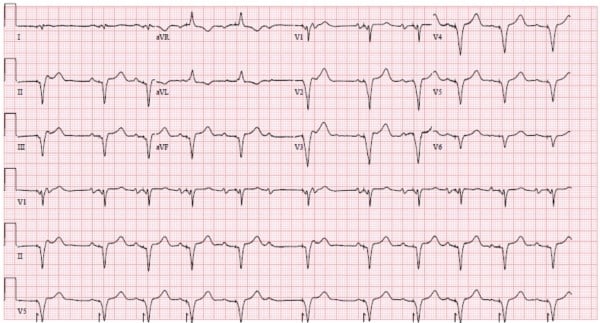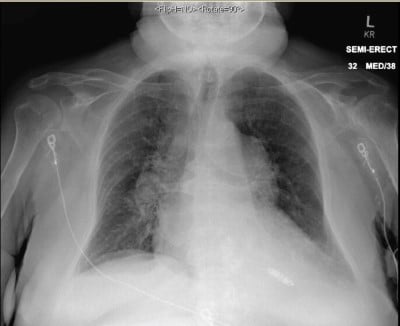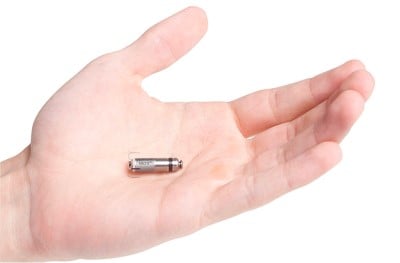A 68-year-old woman with a history of end-stage renal disease, hypertension, diabetes, bradycardia, coronary artery disease, and hypothyroidism presented to the emergency department with bradycardia and hypotension.
She was unable to participate in hemodialysis due to hypotension. The patient was persistently bradycardic with HR in the 50s and hypotensive with SBP in 70s-80s. She reported taking midodrine 15 mg TID and was compliant. Physical exam revealed an alert woman in no acute distress. Lungs were clear to auscultation bilaterally. Cardiac exam showed bradycardia with normal peripheral perfusion. Chest wall was normal, without signs of trauma or palpable artificial devices.
Immediately a 12-lead EKG was obtained (Image 1) and was notable for p-waves unrelated to any ventricular beat, consistent with an underlying 3rd degree heart block in addition to a wide complex ventricularly paced rhythm with pacer spikes noted. A prior EKG had shown atrial sensed ventricular pacing.

Image 1: EKG of the patient on arrival
So, what was pacing the patient, if the patient had no automatic implantable cardioverter defibrillator (AICD)/pacemaker on physical exam?
A CXR was ordered (Image 2) and read by the radiologist as “cardiac loop recorder is seen over the left lower chest.” A leadless loop recorder, however, is a subcutaneously placed device used to evaluate unexplained episodes of palpitations or syncope and has no pacing function.

Image 2: Chest X-Ray of patient on arrival
If the device wasn’t a loop recorder, then what was it?
This device was, in fact, a permanent leadless cardiac pacemaker (Image 3). This cardiac conduction device was introduced in 2020 and has been slowly gaining in popularity since.

Image 3: A permanent leadless cardiac pacemaker device
These pacemakers are inserted percutaneously via the femoral approach, and they are implanted directly in the right ventricle with the help of 4 small metal tines. The device is MRI compatible and can be appreciated on CXR and on CT as a bullet-shaped and radiolucent object located in the right ventricle.
Currently there are 2 leadless pacemakers on the market: Micra, made by Medtronic (our patient’s device), and Nanostim, made by Abbott Medical.
Leadless pacemakers are advantageous because many complications of traditional implantable transvenous pacemakers — such as pocket infections, lead dislodgement, hematomas, and lead fractures — are eliminated. Conversely, they only apply single chamber ventricular pacing and also lack defibrillation capacity.
It is also important to differentiate a leadless cardiac pacemaker from a cardiac loop recorder. The difference is subtle on the AP view as they may look similar, but the difference is clear on the lateral view and on physical exam as the loop recorder is placed subcutaneously whereas the permanent leadless cardiac pacemaker is within the ventricle.
This patient was ultimately admitted to the CCU and had her permanent leadless cardiac pacemaker interrogated. Atrial sensing thresholds were found to be too low and adjusted. The patient did have improvement of HR after adjustment but ultimately passed away in the CCU due to multiple comorbidities.
Key Points
- A leadless pacemaker can be appreciated on CXR and on CT as a bullet-shaped and radiolucent object located in the right ventricle.
- A leadless pacemaker can be easily mistaken as a cardiac loop recorder on AP view of CXR. It can be differentiated on CXR lateral view and on physical exam.
- Leadless pacemakers only apply single chamber ventricular pacing and lack defibrillation capacity.
- Low atrial sensing threshold can lead to serious conduction abnormality and hemodynamic instability and require emergency evaluation by EP cardiology.
References
Conyers JM, Rajiah P, Ahn R, Abbara S, Saboo SS. Imaging features of leadless cardiovascular devices. Diagn Interv Radiol. 2018;24(4):203-208. doi:10.5152/dir.2018.17462
Ngo L, Nour D, Denman RA, et al. Safety and Efficacy of Leadless Pacemakers: A Systematic Review and Meta-Analysis. J Am Heart Assoc. 2021;10(13):e019212. doi:10.1161/JAHA.120.019212
Reynolds D, Duray GZ, Omar R, et al. A leadless intracardiac transcatheter pacing system. New England Journal of Medicine. 2016;374(6):533-541. doi:10.1056/nejmoa1511643



